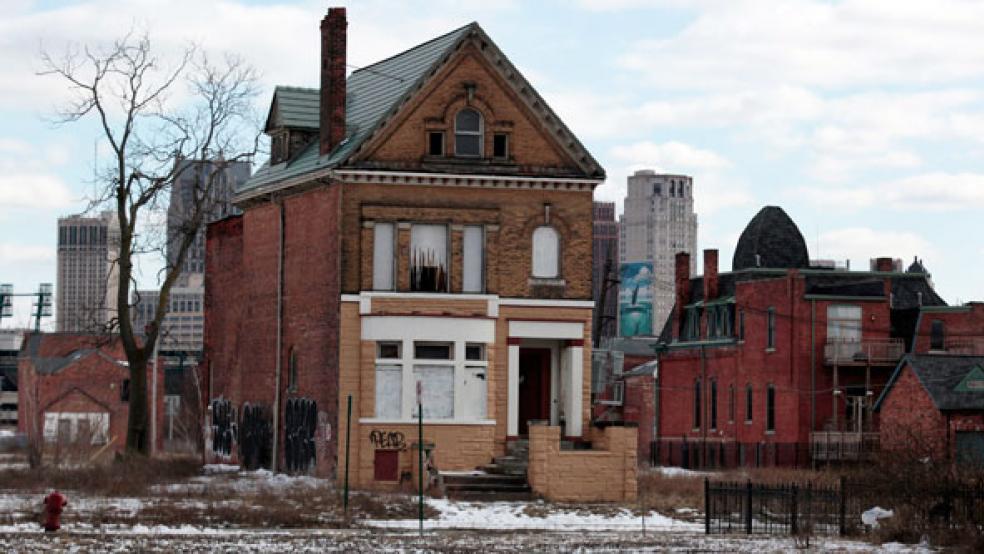Detroit’s massive bankruptcy woes were born of some of the worst municipal financial management and corruption imaginable.
Arguably, one of the biggest obstacles to the Motor City’s efforts to resolve more than $18 billion of long-term debt was persuading major banks to let the city out of the preposterously unfavorable loan terms that were negotiated by former mayor Kwame M. Kilpatrick who was sentenced last October to 28 years in federal prison after being convicted of two dozen counts of corruption, racketeering and extortion.
Back in 2005 and 2006, the now discredited Kilpatrick administration negotiated a deal to borrow $1.4 billion for the city’s vastly underfunded pension program. The city brokered the “interest rate swap” agreement in order to secure a steady interest rate of 6 percent on the massive debt loan. The deal soured after interest rates began to plummet during the economic crisis, leaving Detroit with a $50 million a year bill from the two banks, according to the Detroit Free Press.
Related: Signs of Hope in Detroit’s Historic Bankruptcy Case
Ironically, in the wake of the worst municipal bankruptcy in U.S. history, Detroit and Michigan state officials are resorting to some of the most creative and cutting edge approaches to dig the city out of this mess.
Friday marked a milestone of sorts as Michigan Gov. Rick Snyder (R) signed bipartisan legislation as part of a “Grand Bargain” between the state, philanthropic foundations and the Detroit Institute of Arts that would avert hundreds of millions of cuts from retiree pensions for former city workers. The bargain would also prevent bond insurers and other creditors from forcing the sell-off of the museum’s treasure of Van Gogh’s, Picasso’s and other masterpieces.
The state has pledged $195 million to the cause, on top of $366 million from the foundations and a $100 million pledge from the Detroit Institute of Arts. With the state’s substantial financial commitment locked in, “The city will have extra leverage in pushing pensioners and creditors to accept a settlement, pensioners will have added assurance that their retirement savings will be secure and the federal judge overseeing the proceedings will have firmer ground on which to base his rulings,” according to the Detroit Free Press.
Related: Detroit’s 60-Year Decline into Bankruptcy Hell
The pension agreement, struck after lengthy private talks, calls on municipal retirees’ pension checks to be reduced by 4.5 percent – but far less than the cut of at least 26 percent that had been previously requested by the city, The New York Times reports.
Retired police officers and firefighters would see no cuts in their current pension checks, compared with cuts of at least 6 percent that Detroit officials had insisted were needed. Retired municipal workers would receive no further cost-of-living adjustments, while retired cops and firefighters would continue to receive a COLA, but at a diminished level, according to The Times.
Snyder hailed the legislation as a critical and heartening development that shows that a city reeling from massive debt, diminished population and widespread blight is on the rebound.
“It’s exciting for Detroit and for Michigan,” Snyder said today on MSNBC’s Morning Joe. “It’s part of a ‘Grand Bargain’ where we have the foundation community, the Detroit Institute of Arts, labor and the state coming together to provide extra resources to really cushion the blow to retirees for this difficult bankruptcy.”
“And it really creates an environment where hopefully we can all move forward in a very constructive way,” he added. “Detroit’s coming back, and this will help accelerate that.”
Related: Detroit Bankruptcy Is Big Red Flag for Other Cities
For sure, the “Grand Bargain” could still come unraveled. Retirees and city workers have until July 11 to vote on the proposal, which is included in state-appointed emergency manager Kevyn Orr's plan for Detroit's restructuring, Associated Press reported.
If they vote to torpedo the plan, it would be a huge setback. The city filed for the largest Chapter 9 municipal bankruptcy in history last summer, and a trial on the restructuring is set for August. Orr -- a prominent bankruptcy lawyer from Washington, D.C. -- has said his goal is to have Detroit out of bankruptcy by the end of this summer, but that may be an overly ambitious goal.
But if Snyder, Orr and Detroit officials and boosters can pull this off, the “Grand Bargain” to salvage the pension programs “could serve as a model for other troubled governments,” according to an analysis earlier this week by the New York Times.
An important legal issue raised in the bankruptcy case is whether a government pension plan can be legally cut in bankruptcy. Federal bankruptcy Judge Steven Rhodes has ruled that the city can make those cuts, contrary to a provision of Michigan’s state constitution.
Detroit, which over the years has maintained a pension system it couldn’t afford, struck a tentative agreement with union leaders for a new system that preserves some but not all benefits while putting the program on a much sounder financial footing.
Until now, retired and active workers alike have taken part in the same city pension system. But the new plan is intended only for Detroit’s active workers, and they are scheduled to shift to it on July1. Retirees will keep 73 percent to 100 percent of their current base pensions under the city’s proposal.
The new plan has been labeled a hybrid, “which means the workers will keep some of their current plan’s most valuable features but will give up others,” according to The New York Times. “Trading down to a less generous pension plan is often said to be a legal nonstarter for government workers, so if Detroit succeeds, its hybrid could become a model for other distressed governments from Maine to California.”
Top Reads from The Fiscal Times





